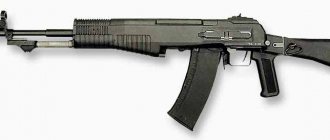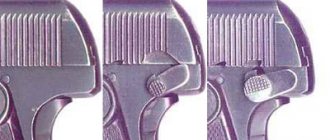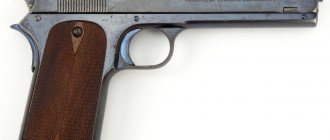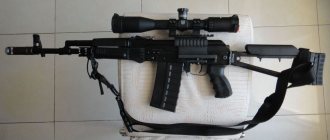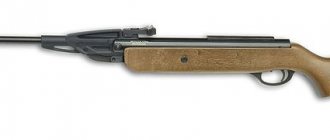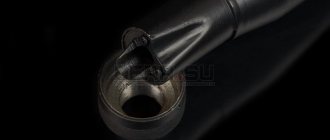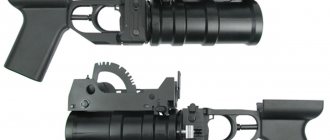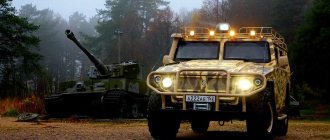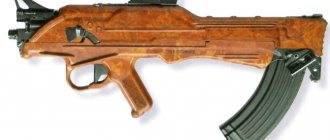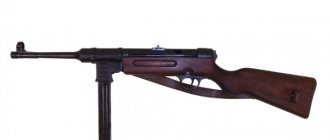The experience of the First World War showed that several dozen people with rifles and a couple of machine guns holed up in a shelter created an almost insurmountable defensive line. Only a massive artillery strike, which practically “dug up” the enemy’s positions, helped to take it. Without artillery support, even a multiple advantage in manpower did not help the attackers. The reasons for this were seen in the low density of fire in the rifle chain. Magazine rifles and rare light machine guns could not completely suppress enemy fire, which practically knocked out the first ranks of soldiers.
The way out of the impasse was the introduction of light automatic weapons into the troops - light machine guns, automatic rifles and submachine guns. One of the first successful examples of this weapon was the American Thompson submachine gun. Note that in the twenties there was no division into machine guns and submachine guns, so these concepts in the article are considered equivalent, although the creator of the weapon, General John T. Thompson himself, used the term - submachine-gun (SMG), translated something like “ sub-machine gun” or “sub-machine gun”.
Thompson Brain Shooter
Best Price Guarantee
- Height: 46 cm
- Ø throat: 30 mm
Thompson Brain Shooter is a 46 centimeter long glass murder weapon and one of the most stylish and exotic devices in the King-Bong collection.
As the name suggests, this bong is shaped like a Thompson submachine gun. It is a textured flask with two handles and a conventional magazine. Part of the butt is also a convenient stand and, in a vertical position, simultaneously serves as a reservoir for liquids. On the side there is a classic grinder with a metal bucket, as well as a hole for targeted shots. The throat width of this bong is 30 millimeters.
In this case, the name of the bong is entirely played up by its device and design. Thompson Brain Shooter is a true brain destroyer that always hits the target.
Source
Thompson Brain Shooter
Best Price Guarantee
- Height: 46 cm
- Ø throat: 30 mm
Thompson Brain Shooter is a 46 centimeter long glass murder weapon and one of the most stylish and exotic devices in the King-Bong collection.
As the name suggests, this bong is shaped like a Thompson submachine gun. It is a textured flask with two handles and a conventional magazine. Part of the butt is also a convenient stand and, in a vertical position, simultaneously serves as a reservoir for liquids. On the side there is a classic grinder with a metal bucket, as well as a hole for targeted shots. The throat width of this bong is 30 millimeters.
In this case, the name of the bong is entirely played up by its device and design. Thompson Brain Shooter is a true brain destroyer that always hits the target.
Source
Thompson submachine gun - a weapon of the mafia
The experience of the First World War showed that several dozen people with rifles and a couple of machine guns holed up in a shelter created an almost insurmountable defensive line. Only a massive artillery strike, which practically “dug up” the enemy’s positions, helped to take it. Without artillery support, even a multiple advantage in manpower did not help the attackers. The reasons for this were seen in the low density of fire in the rifle chain. Magazine rifles and rare light machine guns could not completely suppress enemy fire, which practically knocked out the first ranks of soldiers.
The way out of the impasse was the introduction of light automatic weapons into the troops - light machine guns, automatic rifles and submachine guns. One of the first successful examples of this weapon was the American Thompson submachine gun. Note that in the twenties there was no division into machine guns and submachine guns, so these concepts in the article are considered equivalent, although the creator of the weapon, General John T. Thompson himself, used the term - submachine-gun (SMG), translated something like “ sub-machine gun” or “sub-machine gun”.
Operating countries[edit]
- Great Britain - During World War II, the United States transferred 651,086 0.45 caliber submachine guns of all brands under the Lend-Lease program.
- Ireland
- Canada
- China - unlicensed copy. Chinese copies of the Thompson submachine gun were produced by the Shanxi and Taiyuan arsenals from the late 20s to the mid-40s. They had a shorter forend with grooves for fingers (there were variants with an American-style forend or with a front handle), were in service until the 50s and took part in the Korean War. During World War II, the United States transferred 63,251 0.45 caliber submachine guns of all brands under the Lend-Lease program.
- Costa Rica - During World War II, the United States transferred 24 Thompson submachine guns under the Lend-Lease program.
- Luxembourg - M1A1 in service 1952-1967, replaced by Uzi.
- Netherlands - during World War II, the United States transferred 3,680 0.45 caliber submachine guns under the Lend-Lease program.
- New Zealand
- Panama - M1928A1 were in service with the Armed Forces of Panama until December 1989, when, during the US invasion of Panama, all Panamanian armed forces were disarmed and disbanded.
- Vietnam - unlicensed copy.
- Russia (USSR) - supplied under Lend-Lease. A total of 135,000 – 137,129 submachine guns of 0.45 caliber of all brands were delivered.
- USA - used by the US Army since 1938.
- France - during World War II, the United States transferred 20,856 0.45 caliber submachine guns of all brands under the Lend-Lease program.
- Sweden
- Serbia (Yugoslavia)
- South Vietnam
Use by organizations
- Cosa Nostra
- Irish Republican Army - Used from 1921 until the 1970s.
How the legendary Thompson was created
General John Toliver Thompson is considered the creator of the submachine gun, although in fact the machine gun was developed on the basis of the Blish bolt group by a team of several American engineers: Oscar Payne, George Goll and Theodor Eickhoff.
But first things first. In 1915, John Thompson became excited about the release of automatic infantry weapons. For this purpose, he acquires a license for a semi-free shutter from the then famous engineer Blish. In 1916, the production company Auto-Ordnance was created. The hired designers begin work.
Thompson submachine gun cartridge caliber 11.43 mm. Device
Tommy gun, Thompson submachine gun, Thompson submachine gun, "Chicago piano", "trench broom", "devilish death machine" and even "engine of trade" - all these are the names of the most "gangster" weapon in the world, which has become a symbol of American gangsters. warrior and proved himself well on the battlefields of World War II.
How the machine gun served in the mafia's arsenal
The “prohibition law” that broke out in the United States in 1920 could not stop people who wanted to take a dose of alcohol from drinking alcohol, but it had a very beneficial effect on smugglers. The profits of illegal immigrants delivering alcohol from Canada (there was no ban on drinking alcohol there) reached sky-high levels.
Where there is a lot of money, there will always be people who want to “protect” such “money dealers”. This led to a sharp increase in organized crime and, inevitable in such a situation, bloody redistribution of spheres of influence.
The bandits quickly and appreciated the advantages of rapid-fire hand weapons. The police, armed with revolvers and pistols, could not resist automatic weapons. In their showdowns, the mafiosi also preferred to use the reliable and fast-firing Thompson submachine gun, which by that time had received a new name “Tommy Gun” for advertising purposes.
The introduction of these weapons into the life of the mafia was so great that it found a place in the great works of American cinema and literature.
The famous Bonnie and Clyde from the film of the same name were armed with Thompson weapons, just like their real prototypes; in the film Some Like It Hot, these weapons are used in mafia showdowns.
Finally, in Mario Puzo's The Godfather, Don Corleone and his son Santino suffered from these same machine guns. In reality, there were so many murders committed with this weapon that the tabloid press excitedly talked about its next use.
Here are a few excerpts from famous murders:
- 09/25/1925, execution by competitors of the gang of the “cool” O. Donnell in the city of Chicago;
- 02/14/1929 Al Capone's people shoot 7 people Bugs Moran, also Chicago. This shooting was called the "Valentine's Day Massacre";
- 06/17/1933 “Handsome” Charles Floyd with a couple of other mafiosi shoots four police cars at once, this happened in Kansas City;
- On November 27, 1934, Nelson killed two FBI agents. On November 28, security officers shot Nelson himself during his arrest. The list goes on and on.
Thompson's working principle
The principle of operation of the mechanics of the Thompson assault rifle is based on the semi-free bolt of the original design.
When fired, the recoil slows down not due to the inertia of the massive bolt body, as in a free bolt, but due to the friction that occurs between the walls of the receiver and the extensions of the Blish bronze insert.
The cartridge is fed into the chamber from the magazine when the bolt is retracted and sent forward, at the moment of retraction the trigger is cocked, when the trigger is pressed, the hammer is released from the cocking action and the firing pin hits the cartridge primer.
The bolt begins to slowly roll back, as it is slowed down by the liner, which rests against the walls of the grooves of the receiver.
The ejector tooth removes the spent cartridge case, a cartridge from the magazine is inserted in its place, and the firing mechanism is cocked. At the end of the recoil, the return spring returns the bolt forward, sending the cartridge into the chamber.
Use of a machine gun during World War II
Although the combat use of the Thompson submachine gun was limited by its large weight, even despite the advent of a box magazine with a reduced number of cartridges, as well as bulkiness, it left a certain mark on combat operations.
From 1940 to 1944, the US industry produced almost 1,400,00 Thompson assault rifles.
It was used in combat on almost all fronts where the Americans fought. It was used in North Africa, and quite a few copies of this weapon were among the troops that landed in Europe.
In battles against Japan, its use was noted after a turning point during the fighting. There are widely known images of paratroopers in Okinawa armed with Tommy guns. The machine gun entered the British Army as part of the Lend-Lease program.
The USSR received about 75,000 machine guns, mainly as part of heavy weapons. The British sought to saturate their units with automatic weapons as much as possible (due to the relatively small population of the country, the divisions required maximum striking power), so they were happy with all the automatic weapons.
The USSR, on the other hand, did not express much enthusiasm. Soviet machine guns were not inferior to them in terms of characteristics, and there were many of them. The industry produced more than 6 million Shpagin PPSh assault rifles alone. Nevertheless, images of North Sea sailors with Thompsons in their hands are quite widely known.
In the twenties and thirties, China produced unlicensed Thompson assault rifles and used them against the Japanese invaders.
In addition, the Chinese army received several batches of machine guns under the Lend-Lease program. The Resistance movement in different countries was armed by allies, and Thompson machine guns were supplied among the weapons.
Germany had several thousand of these machine guns captured in 1940 from the British and French and later from Resistance fighters.
A little history
The designer of this weapon is considered to be American Army General John Taliaferro Thompson, after whom the machine gun was named. But some military historians call him only a successful businessman who created a joint company with financier Thomas Rhine, the Auto-Ordnance company. And the true developers are the talented engineers Theodor Eickhoff, Oscar Payne, George Gall, who were hired by Thompson. Also among the authors of weapons can be considered the developer of the semi-blowback, John Blish.
But without Thompson, this famous weapon would still not exist. Everyone admits this. And it all began with an understanding of the results of the First World War, when almost all the warring parties came to the conclusion that the rifles available for service could not cope with the increased mobility of combat operations. And therefore it is necessary to have weapons with an increased rate of fire and a lower mass.
The company produced the first prototype in 1919. The resulting specimen was distinguished by a high rate of fire and reliability for a prototype. For example, during testing it fired at a rate of fire of 1000 rounds per minute, and there was only one delay for 2000 rounds. But by this time the war had already ended and the United States decided that they did not need new weapons, citing the reason for their high cost. Judge for yourself: the average salary in the USA then was about 50-70 dollars, and the price of a Thompson submachine gun was about 225-230 bucks apiece.
The 1921 modification became approximately half the price, but army commanders still did not need it. And then Thompson with his Tommy gun decided to interest law enforcement agencies. And with the slogan “On the side of Law and Order,” the owner went on a tour of the country. But, alas, among law enforcement agencies, only FBI employees were interested in the machine gun.
And the young Soviet Republic purchased a small batch of weapons for the border troops. It was successfully used in the fight against Basmachi detachments. After all, as combat tests showed, 3-4 people armed with Thompson submachine guns were equal in combat power to 9-11 people armed with rifles.
What civilian variants did the machine gun have?
As you know, citizens of the United States of America have the right to freely bear arms.
Still, civilian weapons should have lower characteristics than military ones, so manufacturers have released several versions of sports and civilian assault rifles. True, they were renamed self-loading carbines.
Among them, the following models should be noted:
- M1927A1 - Thompson self-loading carbine, the bolt has undergone changes, as a result of which it has lost the ability to fire in bursts;
- M1927A3 is a self-loading sports carbine fired by twenty-second caliber. The weapon became lighter and was successfully used at the shooting range;
- M1927A5 is a self-loading carbine chambered for the standard Colt pistol cartridge. Some of the steel parts were replaced with aluminum, and the barrel was shortened by half (to 5 inches) so that the carbine met US requirements for conventional pistols;
- The Thompson 1927A was produced in 2008 in a small batch, without a stock, with a barrel length of 266 millimeters, but with a disk magazine for fifty rounds.
Models[edit]
- The first prototype of 1919
- Second prototype of 1919
- Thompson M1921 with Cutts compensator, assembled on
- Thompson M1928
- Thompson M1928A1
- Thompson M1
- Thompson M1A1 - simplified version of the Second World War
- Thompson M1923 - prototype tested as a promising light machine gun.
- One of the prototypes of an automatic rifle chambered for .30 Carbine
- Version with integrated silencer for WWII Australian SAS
- A copy of the Thompson, assembled at the Shanxi Arsenal during the war with Japan.
- The Thompson version, produced at the Birmingham Arsenal in the 30s. Cartridge - 9x19 "Parabellum".
What were the main modifications and their performance characteristics?
Despite a significant number of different modifications, Thompson submachine guns had quite a lot in common. First of all, this is the bolt group, which has remained virtually unchanged during numerous alterations and simplifications.
The second is caliber. SMG Thompson - for army units it was produced only in .45 caliber.
During production, the barrel length and finish changed, the magazines changed, from 100-round “pancakes” to short 20 local magazines. The receiver also changed, its production was simplified, and the sighting devices were simplified.
| Model | Weight, g | Length, mm | Rate of fire in min | Shop |
| M1919 | 3750 | 808 | 1500 | disk 100 |
| M1921 | 4690 | 830 | 900 | box-shaped for 20/30 cartridges, disc 50/100 |
| М1928А1 | 4900 | 852 | 900 | box-shaped for 20/30 cartridges, disc 50/100 |
| M1 and M1A1 | 4780 | 811 | 900 | box-shaped for 20/30 rounds |
History of creation[edit]
The new weapon was created at the very end of the First World War by US Army General Thompson under the influence of the German MP-18. Its main purpose was to conduct close combat in cramped trenches and in cities; One of the most powerful pistol cartridges in the world was chosen as ammunition - .45 ACP (11.43x23 mm). The submachine gun turned out to be quite bulky and heavy; the firing range (no more than one hundred meters) and the accuracy of the battle were also quite low. At the same time, the combination of a high rate of fire and the enormous stopping power of a 45-caliber bullet made it a very dangerous melee weapon. Made from high-quality steel, the Thompson was also effective in hand-to-hand combat. The first to adopt it were the US Marine Corps and several police departments. At the same time, he fell into the hands of gangsters, in whose hands he acquired his wide popularity. Many high-profile murders in the United States in the early 30s were committed with this weapon. The Thompson was first used in combat in 1928 in Nicaragua. A significant number of Thompsons were transferred to the IRA mafia in exchange for the supply of alcohol to the United States.
